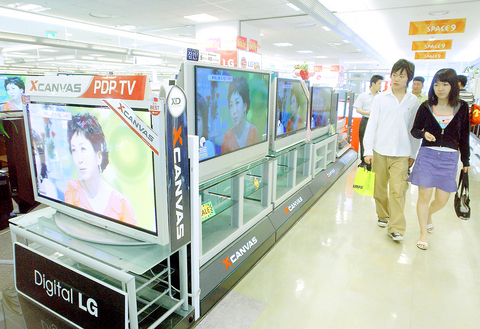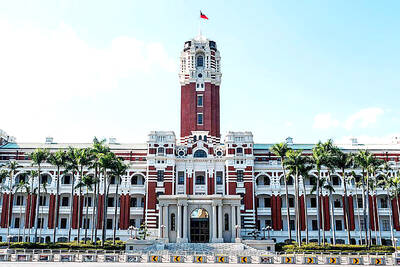Flat panel display screens made of thin plate glass with microscopic light cells inside roll off the assembly lines here for shipping to TV makers worldwide.
As prices fall and quality improves, output is expected to rise sharply and flat panel TVs are forecast to nudge traditional TVs off department store shelves.
South Korea is the world's largest supplier of two most popular types of flat-panel screens -- plasma display panels (PDPs) and liquid crystal displays (LCDs).

PHOTO: AFP
More than half the world's PDP output and nearly half its LCD production come from South Korea.
"This is a global mecca for the display industry," Beh Hong-kyu, Samsung SDI's vice president for public relations, said, referring to the four LCD and three PDP assembly lines at this Samsung plant 90km south of Seoul.
Here at a plant run by Samsung Electronics and sister firm Samsung SDI, workers are feverishly packing LCDs and PDPs destined for 50 global TV makers, including Sony, Philips and JVC.
The hum of the assembly lines here is the death knell to the cathode ray tube (CRT) which has owned the global TV market for decades, according to analysts.
CRTs still prevail but are losing market momentum, Samsung SDI, the world's largest PDP maker, said in a report based on data from key market surveyors, US-based DisplaySearch and Japan-based TSR.
Global CRT sales stood at 172 million units last year, the report said. It predicted sales would drop to 145 million in 2007.
The trend for flat-panel TVs is rapid growth with 2.9 million sold in 2000, 6.7 million in 2002 and 17 million last year, the report said. It forecast 62 million in 2007.
"No doubt that LCDs or PDPs will eventually have superseded CRTs in the future TV market," Lee Young-yong, a senior display market analyst at Daishin Economic Research Institute.
Both PDPs and LCDs use a pair of glass sheets with cells of plasma gas or liquid crystals sandwiched in between. Technology continues to improve and reduce production costs, Samsung SDI said.
"The price for a 32-inch LCD TV will fall to the US$1,500 level later this year, when the demand will explode," Lee said. The 32-inch LCD TVs sold at US$2,500-3,000 per unit last year.
Shim Im-soo, Samsung SDI's executive vice president, also said PDP prices were falling.
"Demand for PDPs will inflate in the second half of this year thanks to the falling prices," Shim said.
PDP prices, which plunged about 40 percent last year, will fall another 28 percent this year, Shim said.
A 42-inch PDP TV, now selling at US$3,900, will be priced about US$2,000 soon.
Though latecomers to the display panel industry, South Korea has been the world's largest supplier of LCDs since 1998 and of PDPs since 2003. Korean producers quickly mastered the technology through audacious investment.
"It is a business which needs heavy investment to take the early lead. Samsung, being run by its owners, could make a quick decision on investment," Shim said.
Samsung SDI and LG Electronics, both South Korean firms, supplied 24.4 percent and 22.0 percent respectively of the global demand for PDPs last year, DisplaySearch said.
Samsung Electronics and LG Philips, a joint venture between LG Electronics and Royal Philips Electronics of the Netherlands, took up 22.0 percent and 19.7 percent each of the global LCD market last year.

DEFENDING DEMOCRACY: Taiwan shares the same values as those that fought in WWII, and nations must unite to halt the expansion of a new authoritarian bloc, Lai said The government yesterday held a commemoration ceremony for Victory in Europe (V-E) Day, joining the rest of the world for the first time to mark the anniversary of the end of World War II in Europe. Taiwan honoring V-E Day signifies “our growing connections with the international community,” President William Lai (賴清德) said at a reception in Taipei on the 80th anniversary of V-E Day. One of the major lessons of World War II is that “authoritarianism and aggression lead only to slaughter, tragedy and greater inequality,” Lai said. Even more importantly, the war also taught people that “those who cherish peace cannot

STEADFAST FRIEND: The bills encourage increased Taiwan-US engagement and address China’s distortion of UN Resolution 2758 to isolate Taiwan internationally The Presidential Office yesterday thanked the US House of Representatives for unanimously passing two Taiwan-related bills highlighting its solid support for Taiwan’s democracy and global participation, and for deepening bilateral relations. One of the bills, the Taiwan Assurance Implementation Act, requires the US Department of State to periodically review its guidelines for engagement with Taiwan, and report to the US Congress on the guidelines and plans to lift self-imposed limitations on US-Taiwan engagement. The other bill is the Taiwan International Solidarity Act, which clarifies that UN Resolution 2758 does not address the issue of the representation of Taiwan or its people in

Taiwanese Olympic badminton men’s doubles gold medalist Wang Chi-lin (王齊麟) and his new partner, Chiu Hsiang-chieh (邱相榤), clinched the men’s doubles title at the Yonex Taipei Open yesterday, becoming the second Taiwanese team to win a title in the tournament. Ranked 19th in the world, the Taiwanese duo defeated Kang Min-hyuk and Ki Dong-ju of South Korea 21-18, 21-15 in a pulsating 43-minute final to clinch their first doubles title after teaming up last year. Wang, the men’s doubles gold medalist at the 2020 and 2024 Olympics, partnered with Chiu in August last year after the retirement of his teammate Lee Yang

The Philippines yesterday criticized a “high-risk” maneuver by a Chinese vessel near the disputed Scarborough Shoal (Huangyan Island, 黃岩島) in a rare incident involving warships from the two navies. The Scarborough Shoal — a triangular chain of reefs and rocks in the contested South China Sea — has been a flash point between the countries since China seized it from the Philippines in 2012. Taiwan also claims the shoal. Monday’s encounter took place approximately 11.8 nautical miles (22km) southeast” of the Scarborough Shoal, the Philippine military said, during ongoing US-Philippine military exercises that Beijing has criticized as destabilizing. “The Chinese frigate BN 554 was